Cricut Do I Remove the Plastic Cover From the Blue Mat
Have you ever wanted to cut vinyl with a Cricut machine, but didn't know how to get started? The good news is that it's actually very easy! This blog post will teach you the simple steps to cut vinyl on your Cricut machine and show you how to get beautiful results every time.
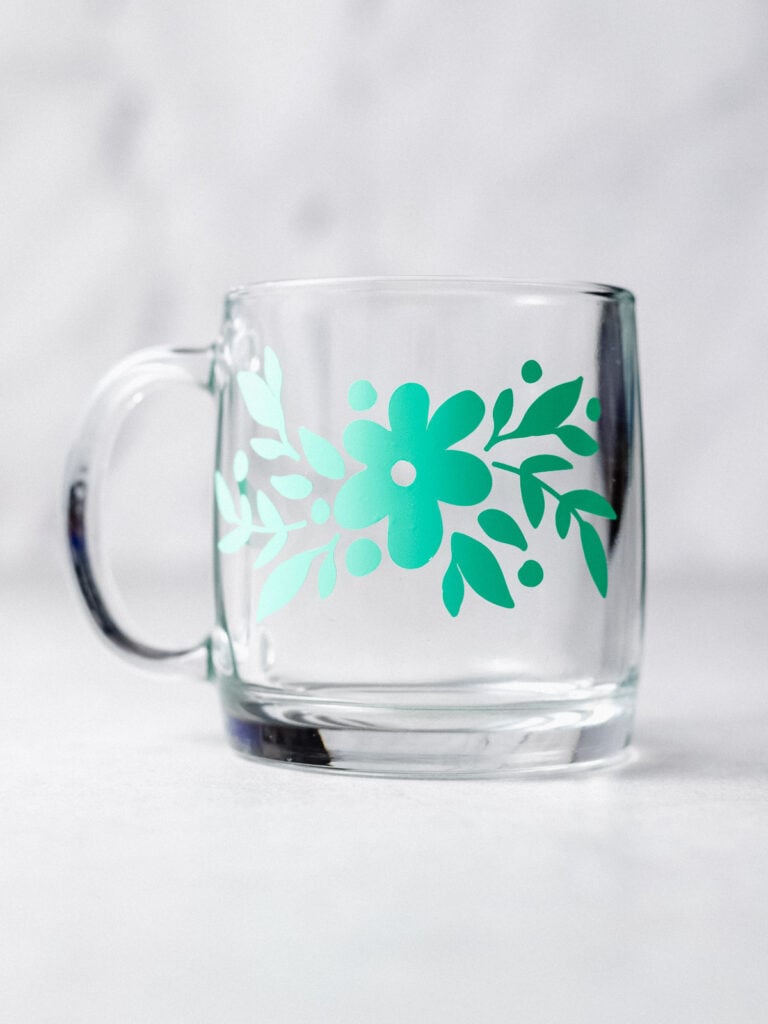
Cricut machines are amazing crafting tools for all kinds of projects, from home decor to personalized gifts and beyond. But cutting vinyl with Cricut can be tricky, especially if you've never done it before.
Whether you are a Cricut beginner or a more experienced crafter, it's worth your time to take a minute and learn how to cut and apply craft vinyl for the best results.
Consider this blog post your ultimate guide to learning how to cut vinyl with your Cricut machine!
I'll explain the two main categories of craft vinyl and help you decide which type of vinyl is right for your project. I'll talk about the supplies you'll need to craft with vinyl, and show you how to cut vinyl with your Cricut machine. After that, I'll give you my best tips for weeding vinyl and applying vinyl for perfect results every time.
Keep reading to learn how to cut vinyl on a Cricut step by step!
What is Vinyl?
Craft vinyl is a flexible and versatile craft material that you can use to make a huge variety of craft projects, including decorated mugs, tumblers, stickers, and decals.
While you can cut vinyl by hand, cutting craft vinyl with a Cricut machine allows you to make precise cuts and intricate designs.
New to Cricut? Read this first: What is a Cricut Machine, and What Can it Do?
Types of Craft Vinyl
In the crafting world, there are two main categories of vinyl: adhesive vinyl and heat transfer vinyl. (Cricut calls their line of heat transfer vinyl by the name "Iron-On" vinyl – but it's the same thing.)
Adhesive vinyl is applied to projects like a sticker. It has an adhesive backing that bonds to the surface of your base material with pressure, not heat.
On the other hand, heat transfer vinyl is applied to fabric surfaces with the heat and pressure of a heat press or household iron.
In this post, we'll be talking about adhesive vinyl. Check out this post to learn all about Heat Transfer Vinyl – aka Iron-On Vinyl.
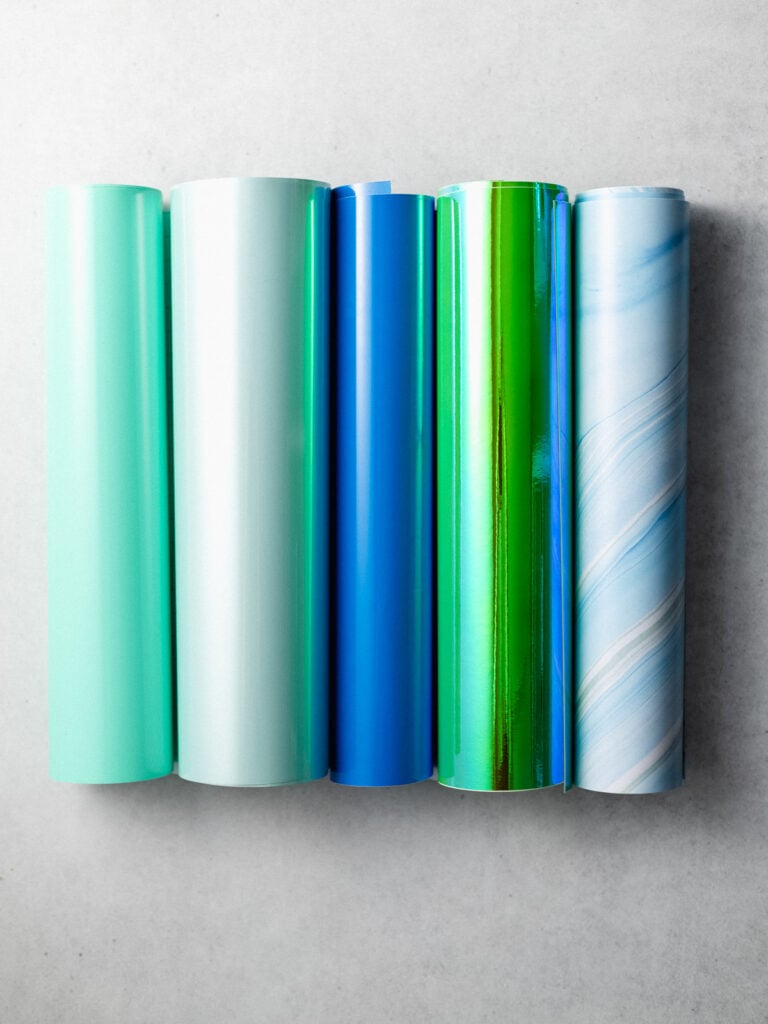
All about Adhesive Vinyl
Let's look at a piece of adhesive vinyl up close. You'll see that your piece of vinyl is made of two different layers. The top layer is vinyl itself, and the second layer is a paper liner. The top vinyl layer has an adhesive backing – like a sticker – and the paper liner protects it until you are ready to apply it to your project.
Colors and Finishes
Adhesive vinyl comes in a variety of finishes and a whole rainbow of colors. You can find glossy and matte vinyl, holographic and glitter vinyl, and everything in between.
Strengths
Adhesive vinyl also comes in different strengths – or levels of stickiness.
Removable Vinyl: This type of craft vinyl has a temporary adhesive that can be removed without leaving any residue behind. It's great for temporary projects and seasonal decor. It's also the best choice for wall decals since it won't damage your paint.
Permanent Vinyl: This type of vinyl has a stronger adhesive for a long-lasting bond. It's great for projects that will get wet – like mugs, cups, and window decals.
For more detail about all the types of adhesive craft vinyl, check out this post: The Ultimate Guide to Craft Vinyl.
Applications
You can apply adhesive vinyl to many different surfaces. It works best on smooth, non-porous surfaces like glass, plastic, glazed ceramic, and even painted walls.
Which vinyl should I use?
The type of vinyl you choose will depend on your base material. That is, what kind of item you want to decorate with the vinyl decal. For indoor walls and temporary decor, choose removable vinyl. For items that will get wet or get a lot of use, choose permanent vinyl.
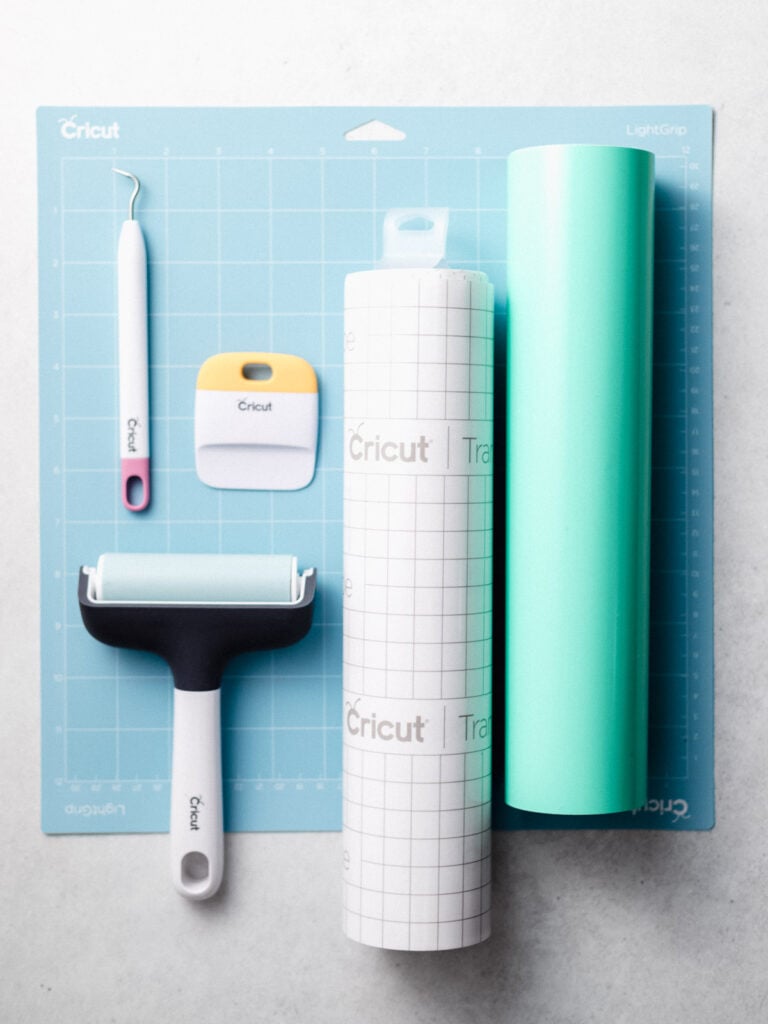
How to Cut Vinyl on a Cricut
Here are the basic supplies and instructions you'll need to follow to cut vinyl with a Cricut. Consider this your overview of the entire process. I've broken down the steps into two parts: cutting the vinyl, and applying the vinyl.
Materials You'll Need
Adhesive vinyl. You can purchase vinyl by the sheet or by the roll.
A Cricut cutting machine. All Cricut models can cut vinyl with a mat. Keep in mind, the Explore and Maker series machine can cut larger shapes than the Joy.
A cutting mat. I like either the blue LightGrip mat or a green StandardGrip mat for cutting vinyl.
Weeding tool. Use this hand tool to remove the unwanted pieces of vinyl from the cut design. You can use a hook-shaped tool or a needle-shaped tool.
Transfer tape. The transfer tape will help you remove the vinyl design from its paper backing, and apply it to the surface of your project. For most types of vinyl, choose regular strength clear transfer tape. For glitter vinyl, choose strong grip transfer tape.
Cutting the Vinyl
- Design your project in Cricut Design Space, or load a pre-made design file.
- Place the vinyl on the cutting mat with the liner side down. Load the cutting mat into the Cricut machine.
- Back in Design Space, choose the appropriate material settings. Load the correct blade into the machine. Press the Go button to begin cutting.
- When the cut is complete, unload the mat. Weed the excess vinyl from the design with a weeding tool.
Applying the Vinyl
- Prepare the surface of your project.
- Apply transfer tape to the vinyl design.
- Peel the transfer tape and vinyl design away from the paper liner.
- Use the transfer tape to apply the vinyl design to the project. Press on the vinyl design to adhere it to the project.
- Slowly and carefully remove the transfer tape, leaving the vinyl design on the project.
Don't worry if these steps seem overwhelming at first. Your first time working with vinyl can feel overwhelming, especially if you are a beginner. With a little bit of practice, I promise you'll get the hang of it.
And if you want more information, keep reading. In the rest of this blog post, I'll go through each of the steps with more specifics. Let's get into it.
Steps to Cut Vinyl with a Cricut Machine
Now that you know the basic steps, let's walk through each part of the process in greater detail.
Step 1. Design your project in Cricut Design Space.
The first step is to open up Cricut Design Space and create a new project. Next, add an image to your Canvas. You can choose one of the pre-made Cricut projects, add an image from the Cricut Access library, or upload your own SVG file. (Or hey, you can even create your own designs with the tools within Design Space.)
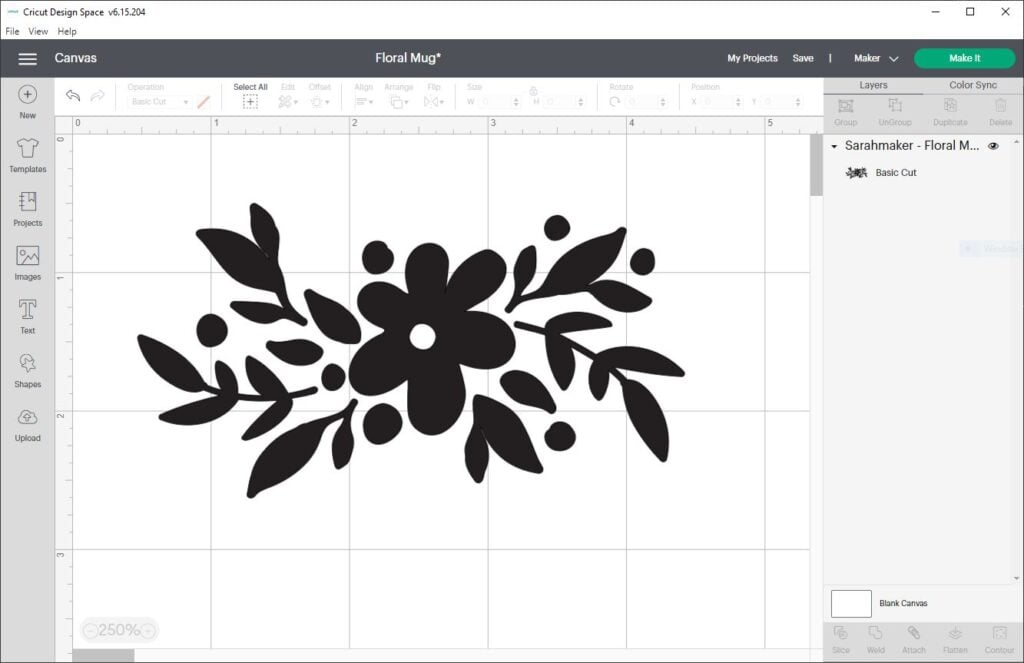
When your design is ready, click the green Make It button.
On the next screen (the Prepare screen), you'll see the pieces of your project separated into mats by color. Double-check that everything looks as it should.
If the pieces of your design are not spaced out how you wanted, you may need to go back to the Canvas screen and "Attach" them.
Once everything looks the way it should, click the green Continue button.
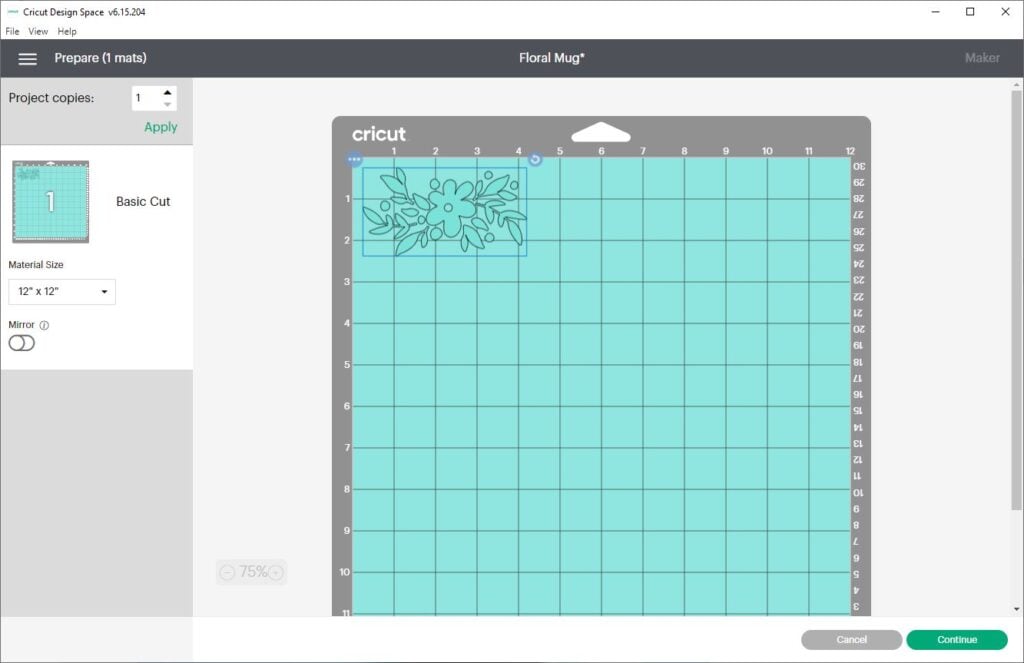
Step 2: Place the vinyl on the Cricut mat.
Lay the blue or green cutting mat on a flat surface, and remove the clear plastic protective sheet. Lay the vinyl onto the mat, with the paper liner side down. Try to line up the edges of the vinyl with the grid on the cutting mat.

Smooth the vinyl with your scraper tool or a brayer. Try to get rid of any air bubbles that could interfere with the cut.
Place the cutting mat into the machine. Line the edges of the mat up with the guides. Then press the Load button to load the mat into the machine.
Step 3: Choose the appropriate material settings.
Head back to Design Space. You'll be looking at the Make screen, where you'll choose the correct cut settings for your particular type of vinyl.
Follow the prompts on the screen to Set Base Material. Choose the Vinyl setting from the list of available options. If you don't see Vinyl in your Favorites list, select Browse All Materials to access the complete list of material settings.

Note: If you are using an Explore Air 2 or older machine, you can choose the material settings by turning the Smart Set dial on the machine itself.
Next, make sure that you have loaded the correct cutting blade into the machine. For vinyl, use the fine-point blade.
When you're ready, press the Go button to begin cutting.
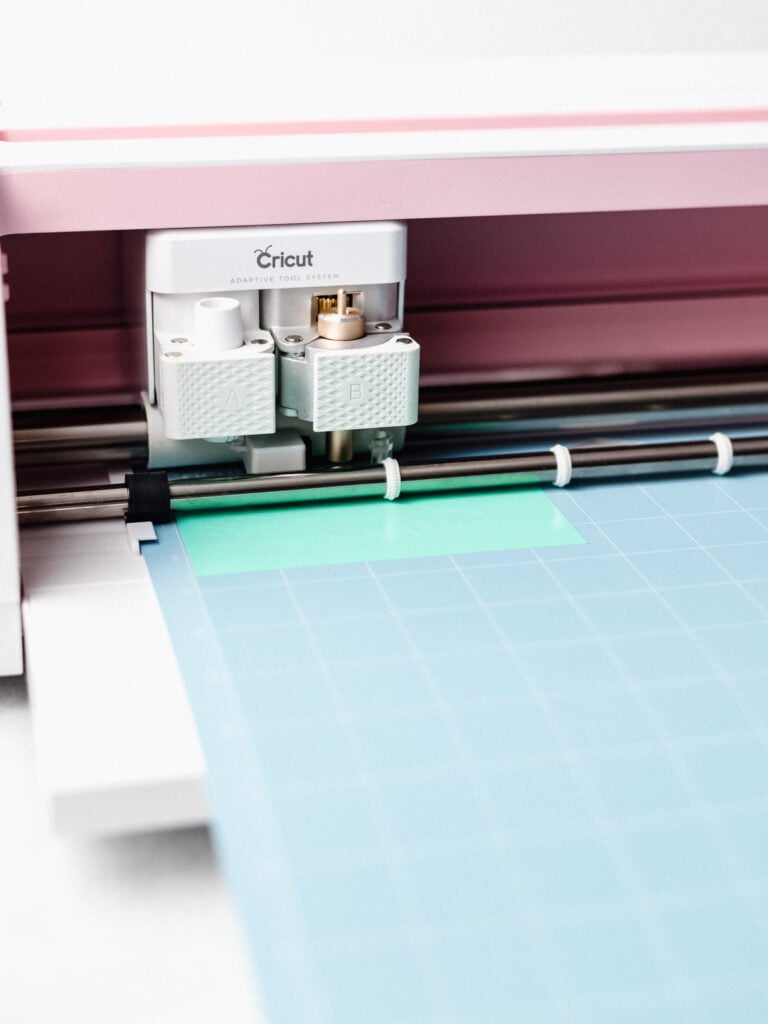
Step 4: Weed the design.
When the cut is complete, press the Load button again to unload the mat. Now, you'll weed the excess vinyl from the design with a weeding tool.
What's weeding? Well, weeding means removing any extra vinyl from the negative spaces around your design that you don't want to be transferred to your final product.
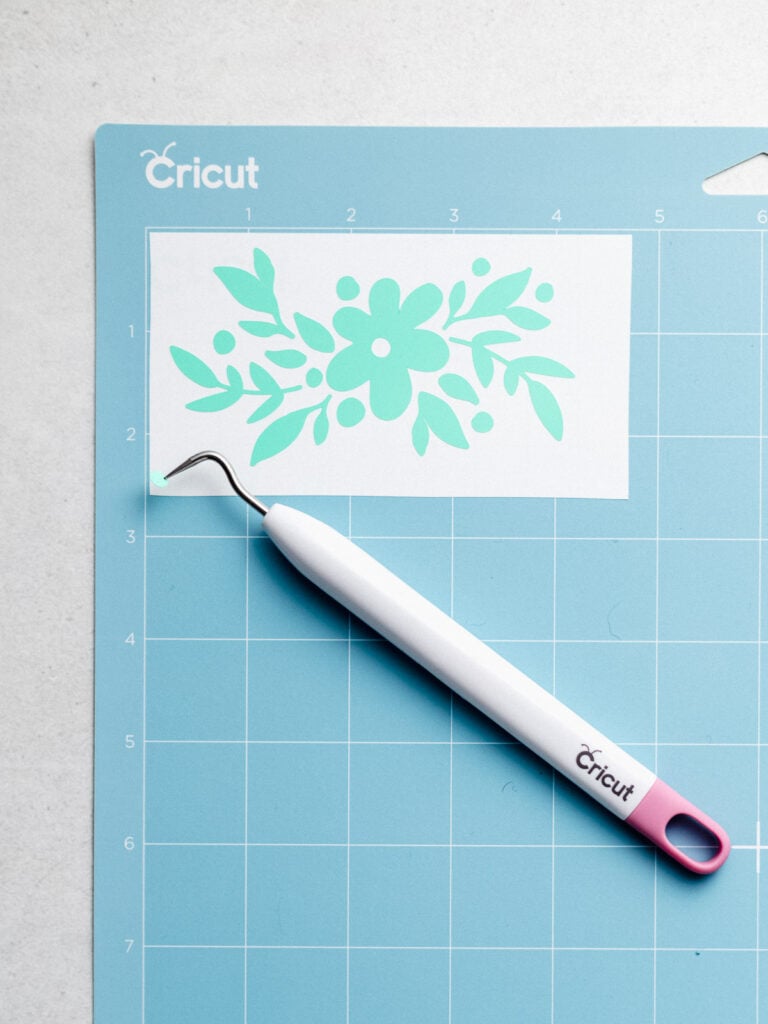
I often weed vinyl while it's still adhered to the mat, because the mat holds the vinyl in place while I work. I tend to remove the larger pieces from the edges of my design first, and then remove the smaller pieces.
Tip: If you have trouble seeing the cut lines on your design, take the vinyl off the mat and hold it up to a window. The extra light should shine through the design, and help you see where to weed.
Use the pointed end of the tool the remove any parts of the image that you don't want to apply to your project. This includes the outer edges as well as the small interior shapes. Don't forget about the little pieces letters like "a" and "o."
Next, flip the cutting mat upside down onto a clean work surface, and peel the mat away from the vinyl. Peeling the mat from the vinyl, instead of the other way around, will help protect the vinyl from curling, bubbling, or ripping.
Step 5: Prepare the surface of your project.
Make sure that the surface of your project base material is clean and dry before applying the vinyl. You'll want to remove any dust, lint, or oil that could prevent the vinyl from adhering to the surface.
For example, if you are making a mug, you can wipe the surface with a small amount of rubbing alcohol and a lint-free cloth.
And if you are working with something round, like a mug, you can position it on a folded towel to keep it from rolling around on the table while you try to apply the vinyl.
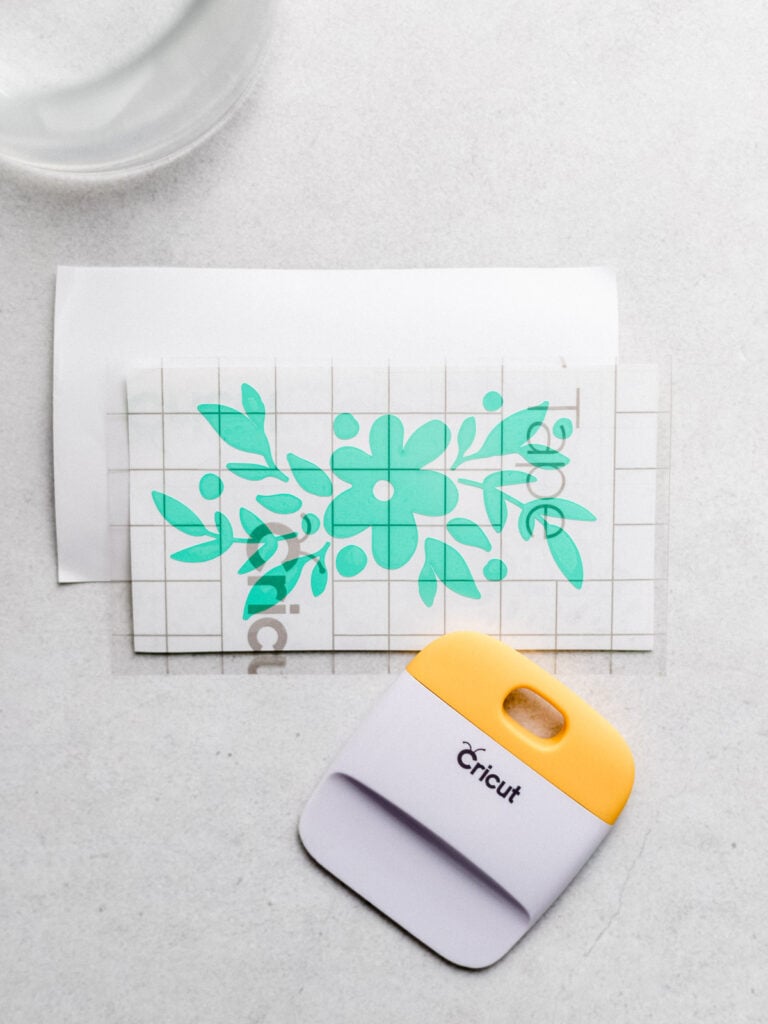
Step 6: Apply the transfer tape to the vinyl design.
Cut a piece of transfer tape that is slightly larger than your vinyl design. Peel the paper backing from the transfer tape. Place the transfer tape onto the vinyl design, using the grid lines to keep everything straight and lined up.
Use a scraper tool to burnish the transfer tape to the vinyl. This will help the transfer tape to hold on to the vinyl design.
Step 7: Peel the transfer tape and vinyl design away from the paper liner.
Gently peel the transfer tape away from the vinyl's paper backing at a 45-degree angle. The transfer tape should lift the vinyl design away from its paper backing. If the vinyl does not stick to the transfer tape, lay the tape back down and burnish it again.
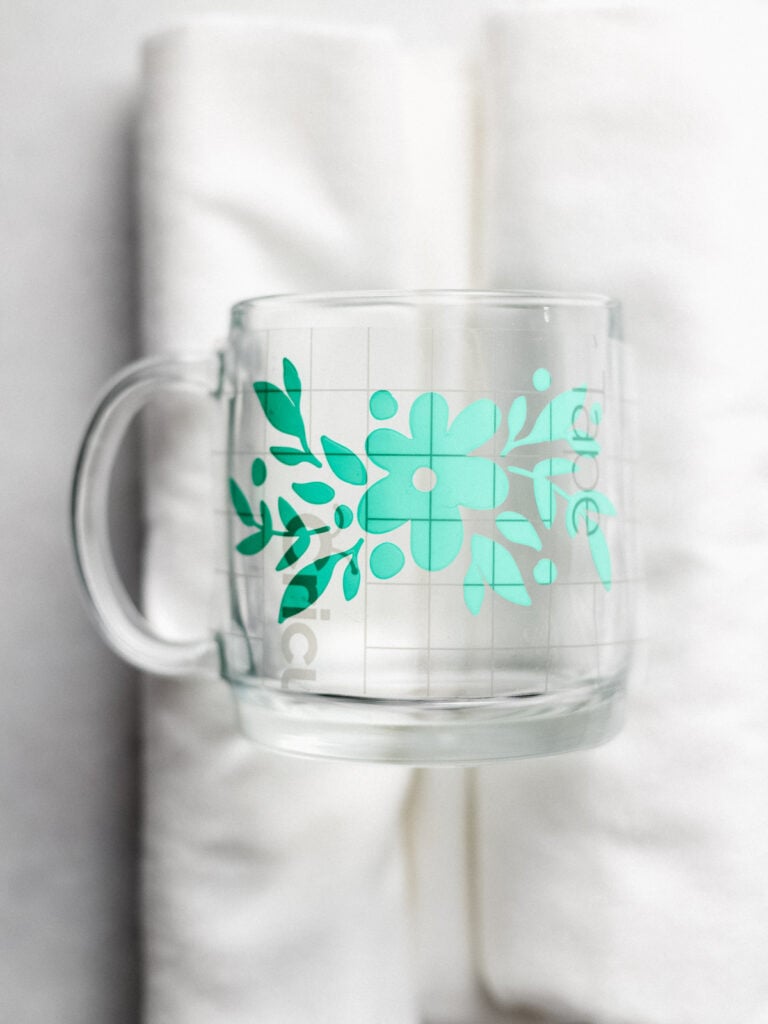
Step 8: Apply the vinyl to the project
Use the transfer tape to place the vinyl design to the project. You can use the grid lines on the transfer tape to make sure your design is perfectly aligned. When your design is in the right place, start pressing on the vinyl to adhere it to the project. Use your scraper tool to burnish the design onto the project. Start in the center of the design and work toward the edges, smoothing out any air bubbles that may form.
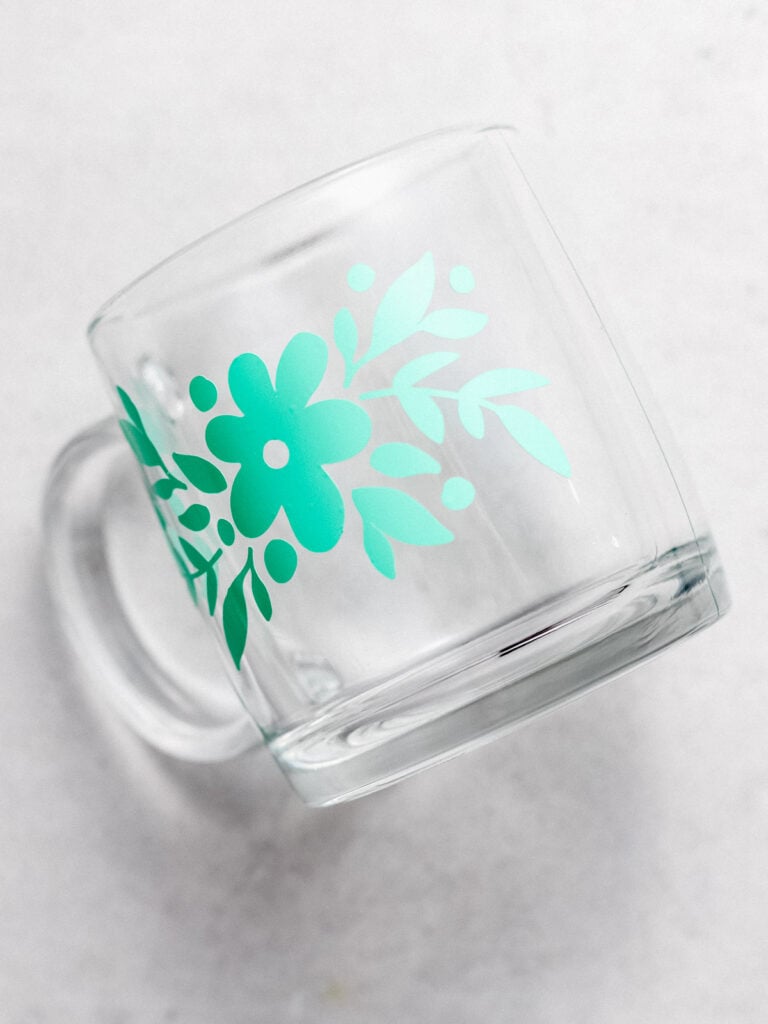
Step 9: Remove the transfer tape.
Slowly and carefully peel the transfer tape away from the surface of the project. Try pulling at a shallow angle – about 45 degrees. The transfer tape should lift away, leaving the vinyl design behind.
If the vinyl design doesn't release from the transfer tape, lay the transfer tape back down, and burnish again. Then, try again.
Now that you've completely removed the transfer tape, you can see your finished design. Allow the vinyl to cure for 24 hours before washing or getting it wet. Letting the vinyl cure will give it time to create a strong bond, and give you the best long-term results.
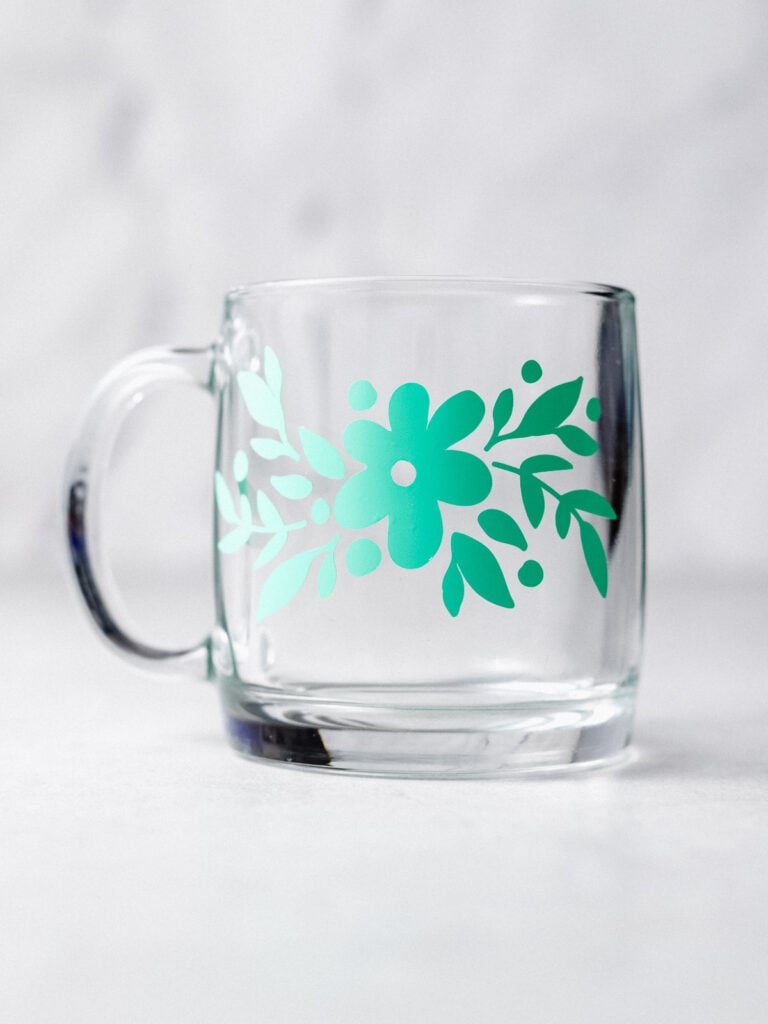
Vinyl Cutting FAQs
Here are some common questions that you may ask as you start to work with vinyl.
Which Cricut is best for vinyl?
All Cricut models can cut vinyl exceptionally well. All three current models – the Explore 3, the Maker 3, and the Cricut joy can cut all types of vinyl.
As you compare the different models, keep in mind that the Cricut Joy is a compact machine designed to cut smaller pieces of vinyl. In contrast, the Cricut Explore series and Maker series machines can make full-size cuts (up to 12″ wide.)
What's the best adhesive vinyl?
The best adhesive vinyl for you depends on the project you are trying to make. Like we talked about before, removable vinyl is best for temporary, indoor projects. And permanent vinyl is best for projects that will see heavy use or need to be washed.
If you're looking for the best brands of adhesive vinyl, I can recommend Oracal 631 (removable vinyl), Oracal 651 (permanent vinyl), and Cricut vinyl.
Which side of the vinyl goes down?
Adhesive vinyl has two layers: the colorful top layer, and the bottom paper backing. Place the paper backing face down on the mat, with the colored vinyl layer facing up.
How do I load vinyl on a Cricut?
All current Cricut models can cut vinyl loaded onto cutting mats. The newer Cricut models – Explore 3, Maker 3, and Joy – can cut Smart Vinyl materials without a mat.
To load vinyl onto a cutting mat, place it paper backing side down onto the mat. Place the mat into the mat guides on the Cricut machine, and press the Load button to load it into the machine.
Do I take the backing off the vinyl before cutting?
No, do not remove the paper backing before cutting the vinyl. The paper backing protects the vinyl adhesive until it's time to apply the vinyl to your project.
Which mat should I use for vinyl?
There are 4 different types of Cricut cutting mats, and each is designed for a different purpose. The blue LightGrip mat and the green StandardGrip mat are the best choices for cutting vinyl.
If you have one of the new machine models, you can even cut without a mat. The Explore 3, the Maker 3, and the Joy can cut Cricut Smart Vinyl without a mat. This enables you to make super long continuous cuts.
What settings should I use to cut vinyl?
Select the Vinyl material option for the correct cut settings.
For Cricut Explore Air 2 machines (and older), turn the Smart Set dial to the pre-set Vinyl option.
For Cricut Maker, Maker 3, and Explore 3 machines, select the cut settings directly in Design Space. On the Make screen, you will see a prompt to Set Base Material. Choose Vinyl, or select Browse All Materials to access the complete list of material settings.
I always recommend doing a small test cut first to double-check your settings before cutting out a large project.
What is a "kiss cut?"
In the craft cutting world, a "kiss cut" is a cut that only goes through the vinyl and leaves the paper liner backing intact.
To get a kiss cut: Select Browse all materials, then select Vinyl from the list of materials.
More Vinyl Tutorials
I hope this ultimate guide to cutting vinyl with Cricut has inspired you to create awesome craft projects. I can't wait to see what you make!
For more information about the Cricut tools you really need, read my Ultimate Guide to Cricut Tools and Accessories.
For even more tips and tricks about crafting with vinyl, be sure to check out these related posts.
- Cricut Comparison: Which Cricut Machine is the Best for You?
- How to Upload Images to Cricut Design Space in 4 Easy Steps
- How to Make Shirts with Cricut Iron-On Vinyl
- How to Make a Stencil with Cricut
What's Next?
Pin this post: Save this tutorial to your Pinterest boards so that you can come back to it later.
Leave a comment: I love to hear your feedback. Tell me in the comments below!
Share on Instagram or Facebook: When you make this project, share it on social media and tag me @sarahmaker. I love to see what you make!

Have questions? Join the Facebook Group!
I hope this article was useful for you! If you have any additional questions, feel free to join my Facebook Group. I created this group for you to share pictures, ask questions, and help each other out.
Instructions
Cutting the Vinyl
- Design your project in Cricut Design Space, or load a pre-made design file.
- Place the vinyl on the cutting mat with the paper liner side down. Smooth with a scraper or brayer tool. Load the cutting mat into the Cricut machine.
- Back in Design Space, choose the appropriate Vinyl material settings. Load the correct blade into the machine. Press the Go button to begin cutting.
- When the cut is complete, unload the mat. Weed the excess vinyl from the design with a weeding tool.
Applying the Vinyl
- Prepare the surface of your project.
- Apply transfer tape to the vinyl design. Burnish with a scraper tool.
- Peel the transfer tape and vinyl design away from the paper liner.
- Use the transfer tape to apply the vinyl design to the project. Burnish the vinyl design to adhere it to the project.
- Slowly and carefully remove the transfer tape, leaving the vinyl design on the project.
Notes
Let the vinyl cure for at least 24 hours before using or washing.

Sarah Stearns has helped thousands of makers find their next craft project with free patterns and step-by-step tutorials on her blog, sarahmaker.com. Read more.
Her work has been featured in The New York Times, Scientific American, Good Housekeeping, Vox, Apartment Therapy, Lifehacker, and more.
morelandsoutimseling.blogspot.com
Source: https://sarahmaker.com/cut-vinyl-cricut/
0 Response to "Cricut Do I Remove the Plastic Cover From the Blue Mat"
Post a Comment